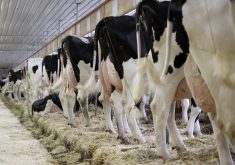Dairy Farmers of Ontario expects the demand for milk in the province to continue to grow, even with potentially significant new volumes of imports from trade deals.
But unlike last year, there were no bold predictions of what that increase in demand means for quota levels.
At last year’s annual general meeting, DFO board chair Ralph Dietrich said the organization expected an increase of six per cent in demand for milk in the province over 2018. That never came to pass and in a month, quota cuts were announced.
Read Also

Ontario’s agri-food sector sets sights on future with Agri-Food 2050 initiative
The first-ever Agri Food 2050, a one-day industry event dedicated to envisioning the future of food and farming in Ontario,…
Dietrich, who stepped down as board chair and didn’t run again for his seat on the board, explained last year’s market signal issue. He said that the board had heard from processors that they needed milk and would for the rest of the year. However, days after the 2018 annual meeting, he said DFO received a much different report from processors.
Why it matters: Dairy farmers have cut cow numbers over the past year due to quota cuts and an absence of fall incentives for milk. They are now looking for signals for what to do in 2019.
“We were caught off guard last year by processor signals,” said Graham Lloyd, general manager of DFO. He said that despite giving up as much as 18 per cent of the Canadian market to imports from the Comprehensive Economic and Trade Agreement (CETA) with Europe, the CPTPP with Pacific countries and the new Canada U.S. Mexico Agreement (CUSMA), it is expected there will be growth for Canadian producers over the next years.
There has been $700 million in processor investments committed in Ontario at various stages of planning and construction.
Lloyd said that DFO and the processors have recently met to try to improve milk demand forecasting.
Murray Sherk, an Oxford County producer and the new board chair, said at the annual meeting in Toronto this year that the direction of quota will be better known after a Jan. 21 meeting of the P5 — the five eastern Canadian provinces that participate in one milk pool. There is new processing capacity coming on stream in 2019 and it is expected that will increase demand.
There is some discussion over the 18 per cent figure as the potential loss of the Canadian market to trade deals. The federal government uses closer to 10 per cent and Lloyd says it depends whether you use 18 per cent or 40 per cent cream in the calculation.















